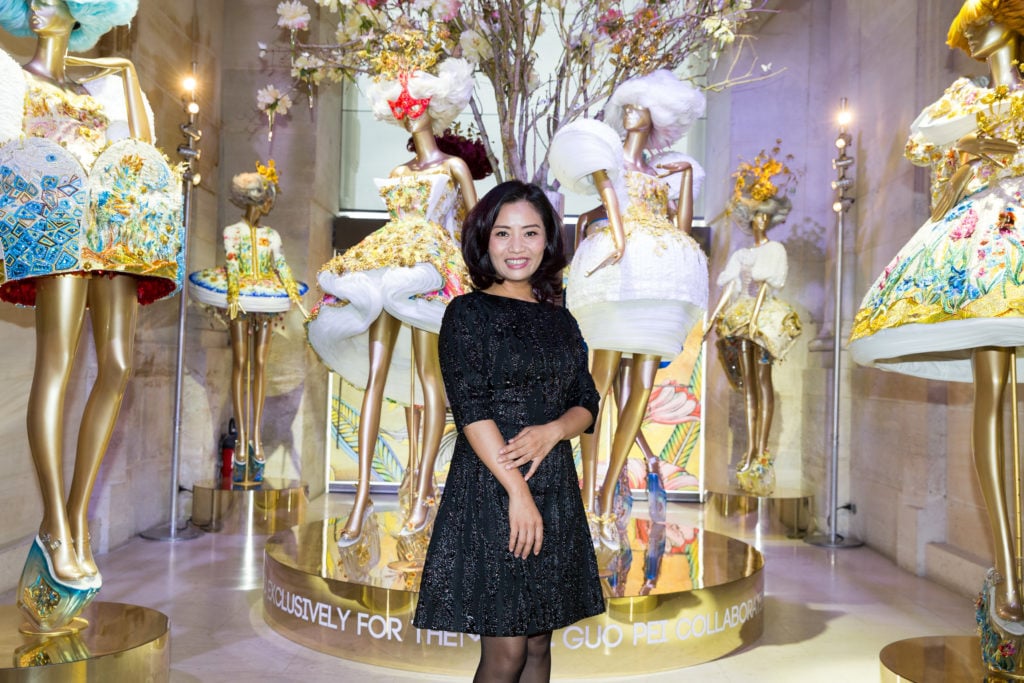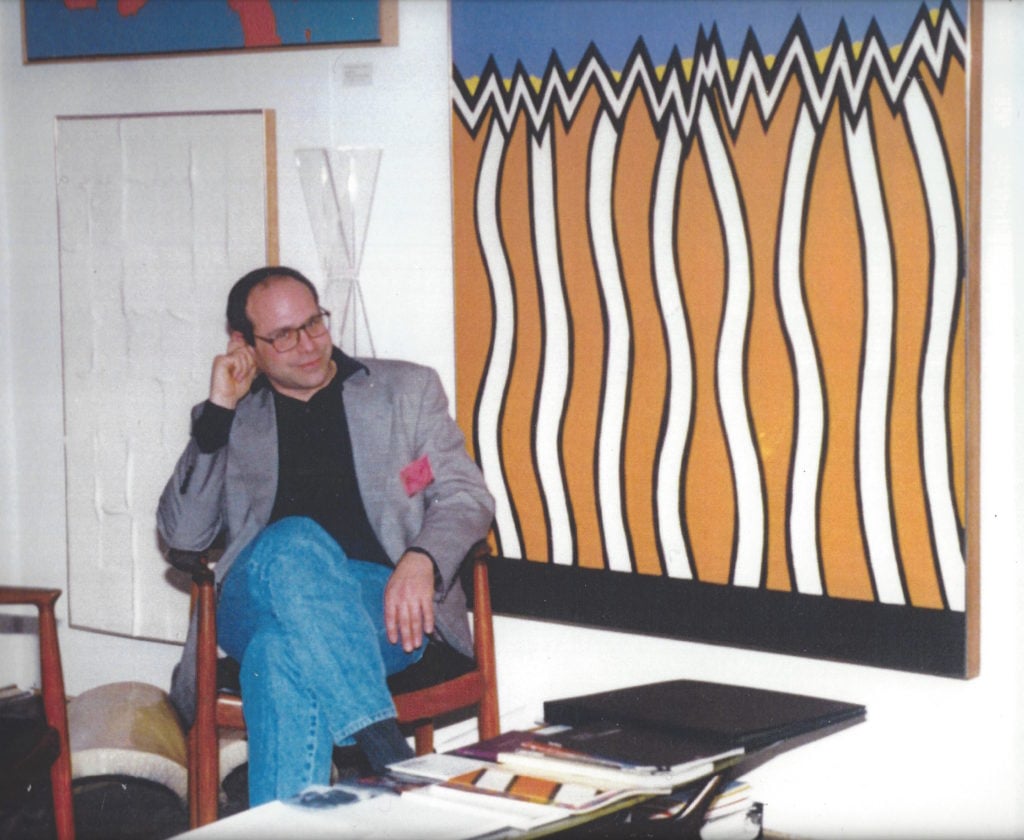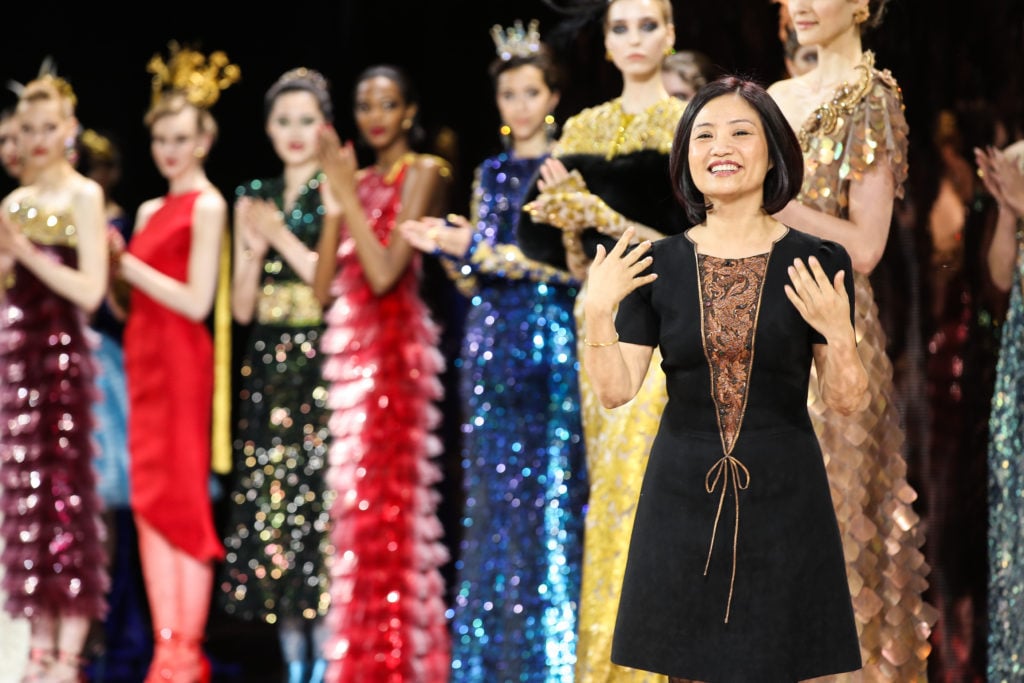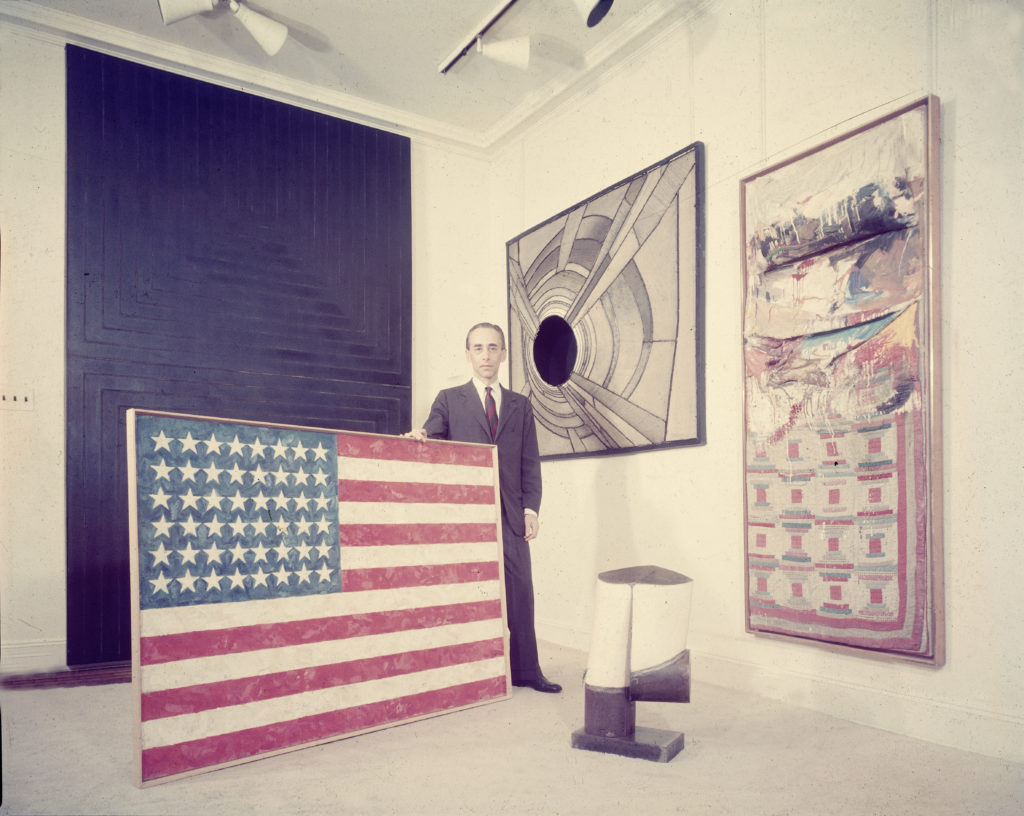Opinion
The Gray Market: Why This Chinese Fashion Designer Could Have a Solution for the Gallery Crisis (and Other Insights)
Our columnist stress tests whether designer Guo Pei's unorthodox business model could apply to the troubled gallery sector.

Our columnist stress tests whether designer Guo Pei's unorthodox business model could apply to the troubled gallery sector.

Tim Schneider

Every Monday morning, artnet News brings you The Gray Market. The column decodes important stories from the previous week—and offers unparalleled insight into the inner workings of the art industry in the process.
This week, turning the news cycle into a thought experiment…
On Tuesday, Andrew Russeth of ARTnews alerted the art world to an Instagram post from longtime path-breaking New York dealer Mitchell Algus, in which he announced his Lower East Side space “is on the verge of closing.” Algus writes that “after nearly 27 years of exhibitions and with a lease pending renewal, the gallery may be unable to continue.”
While this foreboding announcement provides another, all-too-familiar illustration of the challenges of sustainable mid-level art dealing in the 21st century, it also reminds me of an unorthodox possibility for a way out.
For the uninitiated, Algus has earned a well-deserved reputation over the past 27 years for exhibiting colossal but then-under-appreciated talent. Among other artists, he gave early or inaugural shows to Barkley L. Hendricks (whose estate is now with Jack Shainman), Betty Tompkins (now with PPOW, Rodolphe Janssen, and Gavlak), Judith Bernstein (who has held solo exhibitions at Kasmin, the Box, and pre-incarceration Mary Boone in recent years), and Lee Lozano (whose estate is now represented by Hauser & Wirth).

Mitchell Algus, circa 1998, in front of a work by Nicholas Krushenick.
Algus is also refreshingly old school. He does not do art fairs. (In a recent op-ed proposing booth fees be retroactively determined by sales, he accused fairs of “crippling the gallery show.”) He has no permanent staff. He is, in the context of many trust-fund dealers today, shockingly middle-class, supporting most of his art career by teaching science at a Queens public high school from the early ’90s until 2014.
But Algus’s frugality and pension appear to be no match for, on one side, the vampiric New York real-estate market, and on the other, the brand-centric global art market. The only way for him to wriggle out of this vise seems to be by selling more work—a task he has always considered an ill fit with his temperament and his aptitudes. In 2012, he admitted to Russeth that listening to “very well-known dealers” ply their trade “makes my skin crawl,” and in a profile by my colleague Rachel Corbett last spring, he recalled his late-’90s inability to place the same Lee Lozano drawings at $1,500 that Hauser & Wirth began selling shortly thereafter for $65,000.
Hauser’s brand equity and client list weren’t its only advantages. Ironically, the mega-gallery also enjoyed the benefit of a Lozano survey held at MoMA PS1 after curator Bob Nickas discovered the artist’s work at Algus’s gallery. But the point stands: For more than a quarter-century, people have primarily (if too sporadically) bought from Algus because they trust his eye or simply want his influence on the art world to continue, not because of his sales patter or his financial profile. Here’s Russeth:
Without naming names, the amount of money spent by some collectors at one of the mega-galleries for a single trophy artwork could buy a boatload of venturesome art from Algus’s gallery, supporting an enterprise that has been instrumental in making this city, its art scene, and its art historical narratives a great deal more thrilling.
Now, I think the implied exchange here is more important than it might seem at first. By acquiring work from Algus, the argument goes, you aren’t just supporting a given artist and a single dealer. You’re supporting a force (however modest) that has by many accounts continually pushed the entire art ecosystem in compelling directions for decades. It’s about helping to preserve a whole greater than the sum of its parts—and almost doing so in defiance of the traditional gallery business model, which is so brutal in so many ways that I sometimes feel like it could only have been conceived as some form of entrepreneurship S&M.
The whole setup also jogged my memory about an idea from years ago…

Designer Guo Pei walks the runway after her fall/winter 2016-2017 runway show at Paris Fashion Week. (Photo by Richard Bord/Getty Images)
In a 2016 New Yorker piece, Judith Thurman profiled Guo Pei, billed as China’s “first homegrown haute couturier.” Regional novelty aside, Guo’s story stayed with me because of her innovative business model, conceived to counteract the traditionally high-risk, high-reward proposition of (ahem) trying to stay profitable by selling a small number of extremely expensive, labor-intensive objects to wealthy people primarily drawn in by the beauty and prestige of owning something inessential for which they have plenty of other, cheaper options.
Here’s Thurman’s description. (FYI, the “Liu” below is a client, and “Jack” is Guo’s husband, birth name Cao Bao Jie, an “importer and converter of luxury textiles” whose “wealth staked Guo to her career.”)
“We’re all a part of the club,” Liu said gaily, which wasn’t a metaphor. Jack and Guo have a shrewd business plan. “You can’t trust Chinese people to pony up,” Jack told me, “and we can’t afford to spend months on a dress if they don’t.” So patrons of the house pay an annual fee, from which their orders are deducted. The club has four tiers of membership, with subscribers in the top tier spending roughly $800,000. There are about 4,000 subscribers.”
To flesh it out, clients of Guo’s agree to send a (substantial) payment to her every year, even before she has a specific garment they actually want. This payment becomes a credit the client cashes in over the course of the next 12 months (or perhaps more, if it rolls over from year to year) as Guo and her team produce new couture. Guo gets a guaranteed wage up front, which she can use to keep the quality of her line high, and her clients get their choice of new work from a designer they trust. Everybody wins.
Could this same idea work in the gallery world, particularly for someone like Algus, who seems to be valued more for advancing a vision than pushing commodities?
I would actually argue that an ad hoc version of it has been ingrained in the primary market for decades. Many galleries have managed to survive over the years solely because one or two of their most trusted collectors have been willing to buy work they didn’t need to, and in some cases may not even have particularly wanted, just to keep a favorite dealer upright during periods of financial turmoil.
Although I can’t know for sure, I still suspect I experienced at least one of these fairy-godparent deals during the carnage of 2009, when one of my then-gallery’s best clients spontaneously bought almost $200,000 worth of extremely difficult work, by an artist we didn’t even technically represent (and whose work was available elsewhere), roughly a month after nearly all of my coworkers were laid off. I was asked to ship everything directly to storage, and it didn’t leave for years. What I do know is that the gallery survived the recession.
More formal versions of this exchange have been attempted, too, but I think all of them have problems for galleries that Guo’s model barrel-rolls around. Let’s bullet through them, shall we?

Leo Castelli in his gallery. (Photo by Eliot Elisofon/The LIFE Picture Collection/Getty Images)
Dealers from Peggy Guggenheim to Stefan Simchowitz have sometimes paid artists on contract for the rights to most, or all, of the work they produce over a given time period. But the scheme collapses if the dealer cannot consistently find buyers who want all the work they amass. (The same vulnerability applies to the much-romanticized monthly stipends Leo Castelli gave his artists.)
The Friends of Liste program asks collectors to pay into a fund used to subsidize select galleries’ participation in the fair. But Liste is a nonprofit, which justifies why patrons receive nothing tangible in return.
A handful of galleries have launched Patreon campaigns for ongoing crowdfunding from a mostly-online audience. But the low fees, niche appeal, often-intangible incentives, and risk of being viewed as a charity case have so far drastically limited their value.
The most encouraging comparison is probably artist Brad Troemel, who runs a different kind of Patreon business. Among other incentives, he enters subscribers into a monthly lottery for works he has previously exhibited in galleries for prices in the thousands of dollars, as well as a guaranteed “wall work” of some kind for patrons who fund him at certain levels for an entire year.
But this example raises questions, too. The value proposition of Troemel’s Patreon is at least as much about access to a steady torrent of meme-based art-market snark on his subscriber-only social-media feed as it is about acquiring physical artwork. (Depending on your perspective, that online snark may qualify as viral commentary, immaterial art of its own, or just straight-up trolling.) Since a dealer would only be offering the latter in a Guo Pei-like model, and at much higher fees than a few dollars a month, would it translate?
And does the success of Troemel’s largely web-based model actually torpedo the idea that a gallerist like Algus would be able to get funding to maintain a physical space that he has admitted vanishingly few people visit, even in an art capital like New York? Would he even want to?
Can a dealer even strike the necessary balance between the number of “club members,” the cost of membership dues, and the amount of trust necessary to ask for tens of thousands of dollars worth of pre-payment on work when they may not even be able to tell members in advance who the artist(s) making it will be?
In the end, the answer to all of these questions may be “no,” leaving the idea as nothing more than a wild flight of imagination—the business equivalent of former hair-metal icon Bret Michaels describing himself to a contestant on his mind-melting reality-dating show Rock of Love as someone who doesn’t “live inside the box, and [doesn’t] live in the next box outside of that, either.”
But during the one month of the art-world calendar that may actually allow us to downshift, it’s a high concept at least worth thinking about. Just keep in mind that, when we rev back into high gear after Labor Day, not every gallery you love may have survived the heat.
That’s all for this week. ‘Til next time, remember: there’s more than one way summer can be the cruelest season.